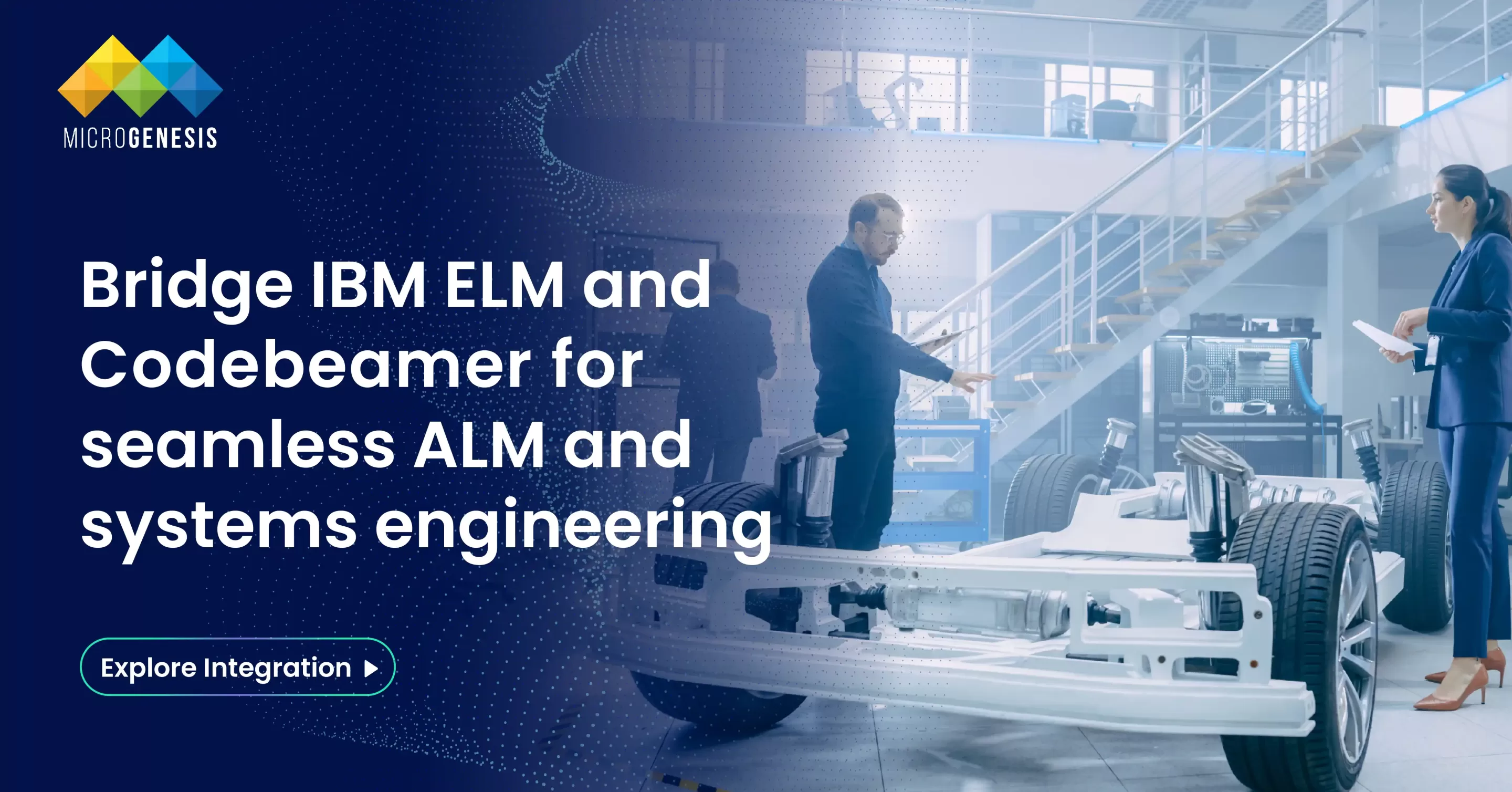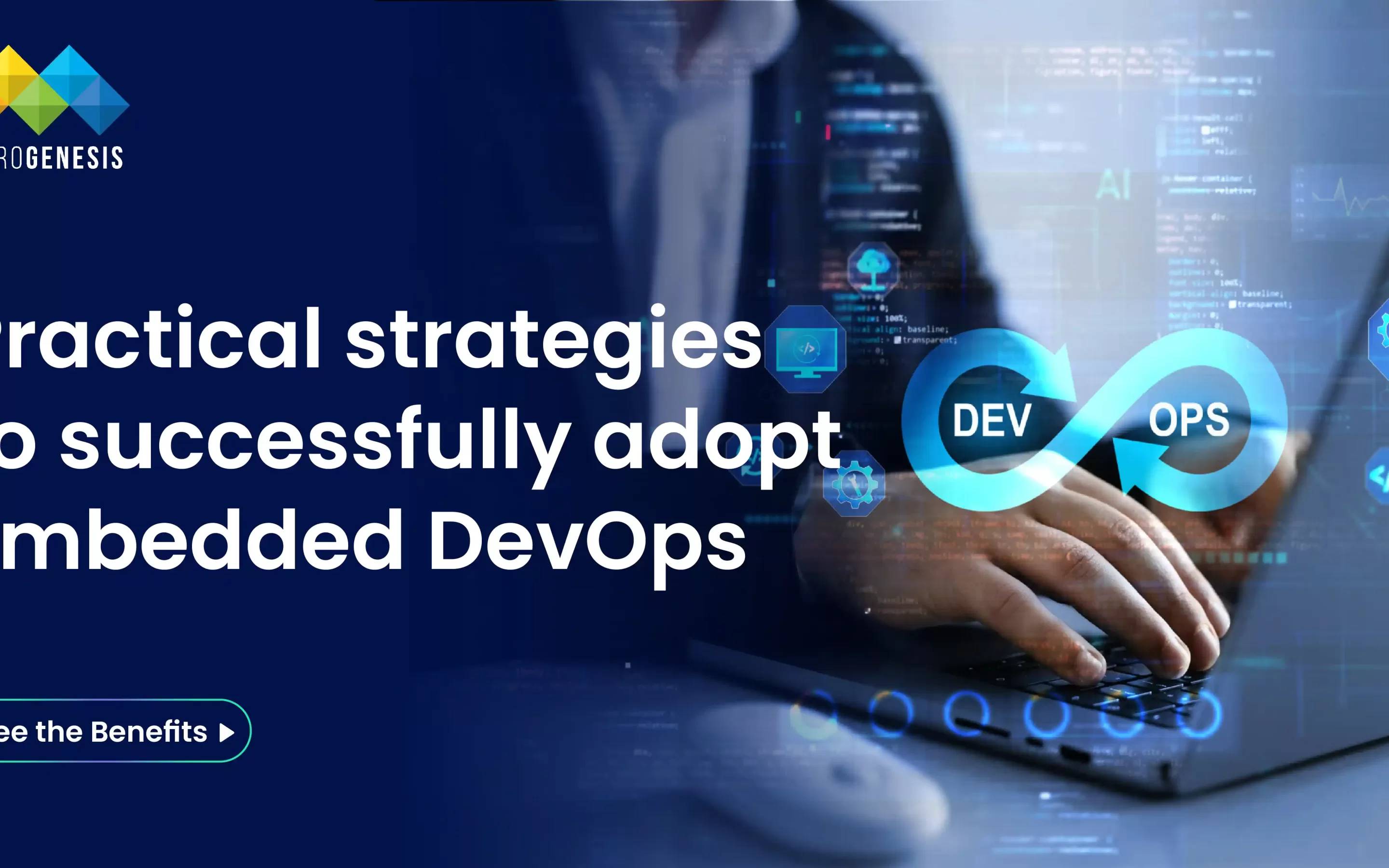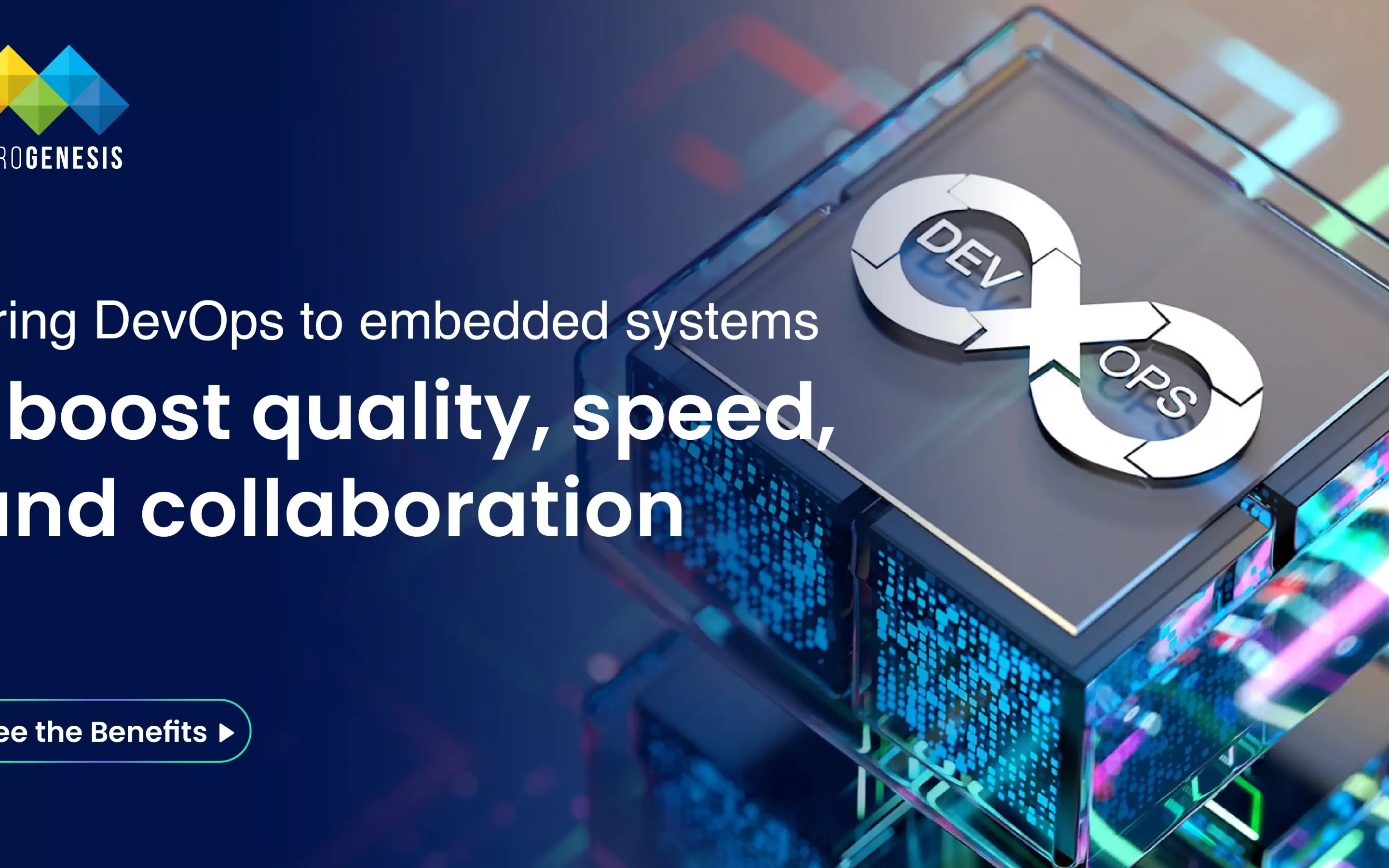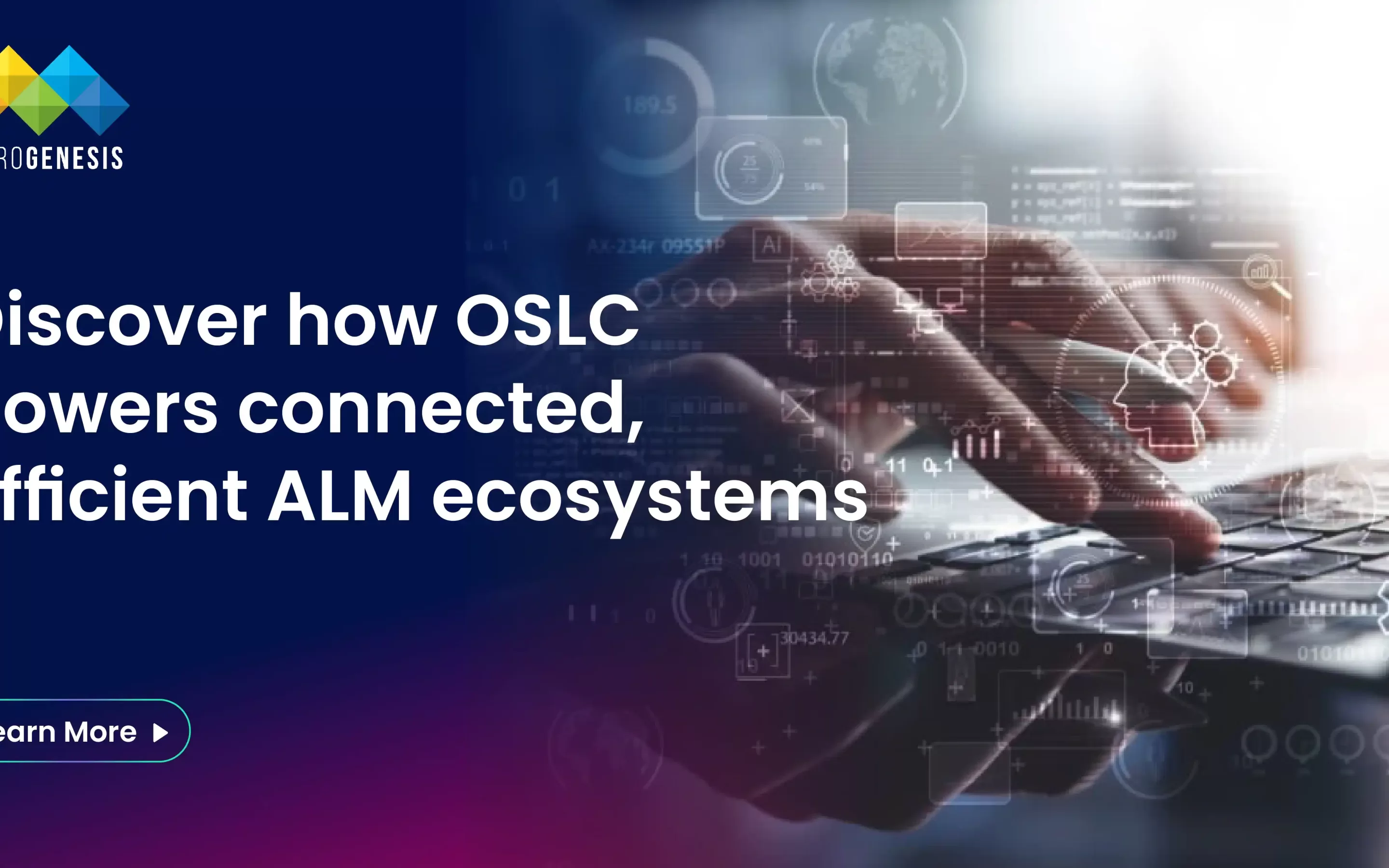The Shift Towards Integrated ALM Ecosystems
In today’s complex engineering and product development environments, software and hardware teams rarely work on a single platform. Large enterprises, especially in regulated industries like automotive, aerospace, and medical devices, often run multiple Application Lifecycle Management (ALM) systems to meet the diverse needs of their teams.
One common pairing is IBM Engineering Lifecycle Management (IBM ELM) and PTC Codebeamer.
- IBM ELM is renowned for its strength in requirements, architecture, test, and change management, often preferred by systems engineering and compliance-focused teams.
- PTC Codebeamer excels in flexible, Agile-friendly development, supporting variant management and end-to-end traceability for software and firmware teams.
While both tools are powerful, siloed usage creates inefficiencies:
- Manual updates between systems waste time.
- Traceability breaks down across platforms.
- Compliance audits become harder to manage.
Cross-platform integration powered by OSLC-based adapters solves these challenges, creating a continuous, end-to-end engineering value stream.
Key drivers for integration:
- Speed: Reduce delays from manual synchronization.
- Accuracy: Keep data consistent between systems.
- Compliance: Maintain traceability for regulatory audits.
2. Understanding the Platforms
IBM ELM
IBM Engineering Lifecycle Management is an enterprise-grade ALM suite designed for large-scale, highly regulated projects.
Key capabilities include:
- Requirements Management (RM): Define, manage, and version complex requirement hierarchies.
- Architecture & Design: Model-based systems engineering (MBSE) support.
- Test Management: Plan, execute, and track test coverage.
- Change & Configuration Management: Ensure controlled updates across the lifecycle.
Industries served:
- Aerospace & Defense (DO-178C, ARP 4754)
- Automotive (ISO 26262, ASPICE)
- Medical Devices (FDA 21 CFR Part 11, ISO 13485)
PTC Codebeamer
Codebeamer is a flexible ALM platform designed for hybrid Agile/Waterfall workflows, making it ideal for fast-moving embedded and software projects.
Key strengths:
- Pure-Variant Configuration Management: Handle product line engineering with minimal redundancy.
- Compliance Templates: Pre-built workflows for ISO 26262, IEC 62304, and other standards.
- Integrated Test & DevOps Support: Supports CI/CD, issue tracking, and Agile boards.
- Traceability: Links across requirements, tests, defects, and source code.
Industries served:
- Automotive suppliers
- Industrial manufacturing
- Healthcare technology
- Consumer electronics
3. Why Integrate IBM ELM and PTC Codebeamer?
Without integration, teams face:
- Duplicated work: Requirements and change requests must be re-entered.
- Loss of traceability: Links break when data isn’t shared across systems.
- Misalignment: Software teams in Codebeamer and systems engineers in ELM work from different versions of truth.
- Audit risks: Missing or inconsistent documentation can fail compliance checks.
Integration benefits:
- Single Source of Truth: Requirements, tests, and changes stay aligned.
- Faster Feedback Loops: Test results and change impacts flow instantly between tools.
- Improved Collaboration: Cross-functional teams can work in their preferred tools without losing visibility.
- Audit-Ready Data: Complete, consistent records for compliance frameworks.
4. How Integration Works: OSLC & REST APIs
OSLC (Open Services for Lifecycle Collaboration)
- Purpose: Standard for linking artifacts between lifecycle tools.
- Function: Creates live, clickable links across platforms, enabling real-time traceability without duplicating data.
- Example: A requirement in IBM ELM can directly link to a related test case in Codebeamer, visible from both sides.
REST APIs
- Purpose: Programmatic interface for creating, reading, updating, and deleting artifacts.
- Function: Supports bulk syncs, transformations, and automation.
- Example: Push all Codebeamer test results into IBM ELM’s test management system nightly.
Why use both?
- OSLC provides live in-browser traceability.
- REST handles backend synchronization for large datasets or event-driven workflows.
- Combined, they deliver full coverage for both real-time collaboration and data consistency.
5. Benefits for ALM and Systems Engineering
1. Live Requirements Synchronization
One of the biggest challenges in multi-tool environments is keeping requirements consistent.
With the IBM ELM–PTC Codebeamer integration, any change to a requirement in one system automatically appears in the other — whether it’s a new specification, an updated acceptance criterion, or a change in priority.
Why it matters:
- Prevents teams from working with outdated specs.
- Eliminates the need for error-prone manual updates.
- Enables parallel development without the risk of diverging requirements.
Example:
If a systems engineer modifies a safety requirement in IBM ELM, the corresponding software requirement in Codebeamer updates instantly — so embedded engineers start implementing the new spec immediately.
2. Automated Change Request Propagation
Change is constant in complex engineering projects. Without integration, every change request must be manually copied between tools — a slow, error-prone process.
With our OSLC-based adapter, when a change request is raised in Codebeamer (for example, due to a test failure), it’s instantly created in IBM ELM with full context and links back to the originating artifact.
Why it matters:
- Keeps systems engineering and development teams on the same page.
- Reduces turnaround time for change evaluation and approval.
- Ensures regulatory documentation stays complete and consistent.
Example:
A bug found in embedded firmware during regression testing in Codebeamer can automatically trigger a linked change request in IBM ELM, enabling the systems team to analyze its impact on higher-level requirements.
3. Test Result Feedback Loops
Testing is only valuable if results reach all stakeholders quickly. With integration, Codebeamer’s test execution outcomes — pass, fail, or blocked — are pushed into IBM ELM’s Engineering Test Management (ETM) module.
Why it matters:
- Gives systems engineers immediate visibility into verification status.
- Makes it easy to demonstrate test coverage for safety-critical requirements.
- Supports rapid defect triage.
Example:
After a nightly Hardware-in-the-Loop (HIL) test run in Codebeamer, results automatically appear in IBM ETM dashboards, showing which high-level requirements are fully validated and which need further work.
4. Audit-Ready Traceability
In regulated industries, traceability is not optional. You must be able to show a complete, verifiable link from requirements → design → implementation → testing → release.
The integration ensures all these links are maintained automatically across platforms — and visible from either side.
Why it matters:
- Simplifies compliance with ISO 26262, DO-178C, IEC 62304, FDA Part 11, and other standards.
- Cuts audit preparation from weeks to days.
- Avoids missing documentation that could delay certifications.
Example:
During an ISO 26262 audit, an assessor can start from a functional safety requirement in IBM ELM and trace it directly to Codebeamer’s test case results and defect records — without manual collation.
5. Unified Reporting
Management and compliance teams often need a single view of project status, but data lives in multiple tools. The integration enables unified dashboards that combine metrics from IBM ELM and Codebeamer.
Why it matters:
- Saves time compared to exporting and merging data manually.
- Supports executive decision-making with complete, real-time information.
- Helps identify bottlenecks and quality risks early.
Example:
A program manager can view a single dashboard showing requirement progress from IBM ELM alongside defect trends and test coverage from Codebeamer, without logging into multiple systems.
6. Reduced Rework & Improved Quality
When teams work with mismatched information, the result is often expensive rework. Integration prevents these misalignments by keeping all artifacts, changes, and test results synchronized in near real-time.
Why it matters:
- Reduces the likelihood of implementing obsolete requirements.
- Catches inconsistencies early, before they propagate downstream.
- Improves final product quality and customer satisfaction.
Example:
Without integration, a developer might code against a requirement that was changed two weeks ago — only discovering the mismatch during acceptance testing. With integration, they’re working on the latest approved version from day one.
6. Industry Use Cases
Automotive Supplier
- Problem: Separate ALM tools for systems engineering and embedded software teams.
- Solution: Integration linked functional safety requirements in IBM ELM with implementation tasks in Codebeamer.
- Result: Faster ASPICE audits, reduced defect rates.
Aerospace Manufacturer
- Problem: Manual export/import of requirements caused delays in certification.
- Solution: Automated sync via OSLC adapter.
- Result: Reduced certification preparation time by 40%.
Medical Device Company
- Problem: Compliance with IEC 62304 required traceability across software and systems.
- Solution: Bi-directional sync of test results and requirements.
- Result: Faster FDA submission process.
7. ROI of Integration
Measurable returns:
- 80% reduction in manual data reconciliation.
- Fewer escaped defects thanks to better traceability.
- Faster audits – from weeks to days.
- 6–9 months payback period in most implementations.
These ROI gains come from time savings, improved quality, and reduced compliance effort.
8. Best Practices for a Successful Integration
A PTC Codebeamer–IBM ELM integration is more than just a technical connection — it’s a process transformation. Following these best practices ensures you gain maximum value while avoiding common pitfalls.
1. Start Small with a Pilot Project
Jumping into a full enterprise rollout can be overwhelming and risky. Instead, select a single project, product line, or program as your proof of concept.
- Why: Limits the initial scope, making it easier to identify and fix issues before scaling.
- How: Choose a project with active collaboration between systems and software teams, so benefits become immediately visible.
- Example: Pilot the integration on a safety-critical subsystem where requirements, changes, and test data flow regularly between ELM and Codebeamer.
2. Define Clear Mappings Upfront
Integration success depends on aligning artifact types, attributes, and relationships between tools.
- Why: Prevents confusion over what each synced field means, ensuring consistent and meaningful data flow.
- How: Create a mapping document that pairs ELM artifacts (e.g., Requirement, Change Request) with Codebeamer equivalents (e.g., Requirement, Task, Issue). Define field-level mappings, mandatory attributes, and link behavior.
- Example: Decide whether “Priority” in ELM maps to “Severity” or “Business Value” in Codebeamer — and ensure both teams understand the choice.
3. Plan for Compliance from Day One
If your industry is regulated, integration must align with compliance needs.
- Why: Retroactively bolting on compliance can cause rework, delays, and audit failures.
- How: Map the integration workflow to your compliance framework (ISO 26262, DO-178C, IEC 62304, FDA 21 CFR Part 11). Ensure traceability, electronic signatures, and versioning are preserved.
- Example: For DO-178C, ensure test cases linked to high-level requirements in ELM are fully traceable to execution results in Codebeamer, including pass/fail status and tester identity.
Read more: The Best ALM Software for Safety-Critical Industries
4. Ensure Enterprise-Grade Security
Integrating systems also means integrating their user authentication and access control.
- Why: Prevents unauthorized access, data leakage, or compliance breaches.
- How: Implement secure authentication methods such as SAML or OAuth, integrate with corporate identity providers (Azure AD, Okta), and respect project-level access controls.
- Example: If a user only has “read” access to certain requirements in ELM, that restriction should also apply when viewing those requirements via Codebeamer links.
5. Train and Enable Your Teams
Technology alone won’t deliver value — people must know how to use it effectively.
- Why: Poor adoption leads to partial use, manual workarounds, and reduced ROI.
- How: Conduct joint training sessions for both ELM and Codebeamer users. Cover the integration workflow, how to create links, how to trace artifacts, and what to do when conflicts arise.
- Example: Show testers in Codebeamer how their results are visible to systems engineers in ELM — motivating them to maintain accurate execution data.
9. How Our Managed Integration Services Help
We offer a full managed service for IBM ELM–PTC Codebeamer integration:
- Assessment & Workshop
- Review your current ALM environment.
- Identify integration needs and compliance goals.
- Custom Configuration
- Configure the OSLC adapter to match your taxonomy, workflows, and compliance templates.
- Deployment & Testing
- Implement and validate integration in staging before production.
- Training & Change Management
- Equip teams to leverage integration effectively.
- Ongoing Support
- SLA-backed maintenance, upgrades, and scaling to new projects.
10. Call-to-Action
If you’re running IBM ELM and PTC Codebeamer separately, you’re leaving efficiency, traceability, and compliance confidence on the table.
With our OSLC-based integration adapter and managed services, you can unlock a unified engineering ecosystem that accelerates delivery while staying audit-ready.
Conclusion:
IBM ELM and PTC Codebeamer integration creates a powerful ecosystem for ALM and systems engineering, enabling seamless collaboration, improved traceability, and stronger compliance across the development lifecycle. By unifying these platforms, organizations can accelerate innovation while reducing risks and costs. To fully leverage this integration, partnering with the right experts is essential. As a trusted digital transformation consultant, MicroGenesis helps enterprises design, implement, and optimize ALM solutions that align with their long-term business goals.




